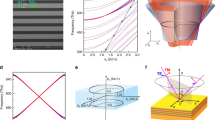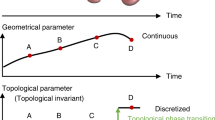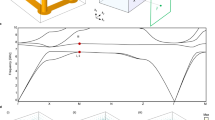Abstract
Topological photonics is rapidly expanding. However, discovering three-dimensional topological electromagnetic systems can be more challenging than electronic systems for two reasons. First, the vectorial nature of electromagnetic waves results in complicated band dispersions, and simple tight-binding-type predictions usually fail. Second, topological electromagnetic surface modes inside the light cone have very low quality factors (Q factors). Here, we propose the concept of scalar topological photonics to address these challenges. Our approach is experimentally validated by employing a nested meta-crystal configuration using connected coaxial waveguides. They exhibit scalar-wave-like band dispersions, making the search for photonic topological phases an easier task. Their surface states have skyrmion-like electric field distributions, resulting in a whole, bright surface state band inside the light cone continuum. As such, the topological surface states in our three-dimensional nested crystals can be exposed to air, making such systems well-suited for practical applications.
This is a preview of subscription content, access via your institution
Access options
Access Nature and 54 other Nature Portfolio journals
Get Nature+, our best-value online-access subscription
$29.99 / 30 days
cancel any time
Subscribe to this journal
Receive 12 print issues and online access
$259.00 per year
only $21.58 per issue
Buy this article
- Purchase on Springer Link
- Instant access to full article PDF
Prices may be subject to local taxes which are calculated during checkout




Similar content being viewed by others
Data availability
All data used in the analysis are available in Figshare with the identifier ‘https://doi.org/10.6084/m9.figshare.22736801’.
References
Hasan, M. Z. & Kane, C. L. Colloquium: topological insulators. Rev. Mod. Phys. 82, 3045–3067 (2010).
Qi, X.-L. & Zhang, S.-C. Topological insulators and superconductors. Rev. Mod. Phys. 83, 1057–1110 (2011).
Chiu, C.-K., Teo, J. C. Y., Schnyder, A. P. & Ryu, S. Classification of topological quantum matter with symmetries. Rev. Mod. Phys. 88, 035005 (2016).
Armitage, N. P., Mele, E. J. & Vishwanath, A. Weyl and Dirac semimetals in three-dimensional solids. Rev. Mod. Phys. 90, 015001 (2018).
Lu, L., Joannopoulos, J. D. & Soljačić, M. Topological photonics. Nat. Photon. 8, 821–829 (2014).
Ozawa, T. et al. Topological photonics. Rev. Mod. Phys. 91, 015006 (2019).
Kim, M., Jacob, Z. & Rho, J. Recent advances in 2D, 3D and higher-order topological photonics. Light Sci. Appl. 9, 130 (2020).
Chen, Z. & Segev, M. Highlighting photonics: looking into the next decade. eLight 1, 2 (2021).
Inan, U. S. & Inan, A. S. Electromagnetic Waves (Prentice Hall, 2000).
Fert, A., Reyren, N. & Cros, V. Magnetic skyrmions: advances in physics and potential applications. Nat. Rev. Mater. 2, 17031 (2017).
Tsesses, S. et al. Optical skyrmion lattice in evanescent electromagnetic fields. Science 361, 993–996 (2018).
Du, L., Yang, A., Zayats, A. V. & Yuan, X. Deep-subwavelength features of photonic skyrmions in a confined electromagnetic field with orbital angular momentum. Nat. Phys. 15, 650–654 (2019).
Davis, T. J. et al. Ultrafast vector imaging of plasmonic skyrmion dynamics with deep subwavelength resolution. Science 368, eaba6415 (2020).
Bogdanov, A. N. & Panagopoulos, C. Physical foundations and basic properties of magnetic skyrmions. Nat. Rev. Phys. 2, 492–498 (2020).
Ibanescu, M., Fink, Y., Fan, S., Thomas, E. L. & Joannopoulos, J. D. An all-dielectric coaxial waveguide. Science 289, 415–419 (2000).
Bradlyn, B. et al. Beyond Dirac and Weyl fermions: unconventional quasiparticles in conventional crystals. Science 353, aaf5037 (2016).
Saba, M., Hamm, J. M., Baumberg, J. J. & Hess, O. Group theoretical route to deterministic Weyl points in chiral photonic lattices. Phys. Rev. Lett. 119, 227401 (2017).
Chang, G. et al. Unconventional chiral fermions and large topological Fermi arcs in RhSi. Phys. Rev. Lett. 119, 206401 (2017).
Tang, P., Zhou, Q. & Zhang, S.-C. Multiple types of topological fermions in transition metal silicides. Phys. Rev. Lett. 119, 206402 (2017).
Zhang, T. et al. Double-Weyl phonons in transition-metal monosilicides. Phys. Rev. Lett. 120, 016401 (2018).
Yang, Y. et al. Topological triply degenerate point with double Fermi arcs. Nat. Phys. 15, 645–649 (2019).
Sanchez, D. S. et al. Topological chiral crystals with helicoid-arc quantum states. Nature 567, 500–505 (2019).
Hasan, M. Z. et al. Weyl, Dirac and high-fold chiral fermions in topological quantum matter. Nat. Rev. Mater. 6, 784–803 (2021).
Mañes, J. L. Existence of bulk chiral fermions and crystal symmetry. Phys. Rev. B 85, 155118 (2012).
Pendry, J. B., Martín-Moreno, L. & Garcia-Vidal, F. J. Mimicking surface plasmons with structured surfaces. Science 305, 847–848 (2004).
Hsu, C. W., Zhen, B., Stone, A. D., Joannopoulos, J. D. & Soljačić, M. Bound states in the continuum. Nat. Rev. Mater. 1, 16048 (2016).
Zhao, E. Topological circuits of inductors and capacitors. Ann. Phys. 399, 289–313 (2018).
Dutt, A. et al. A single photonic cavity with two independent physical synthetic dimensions. Science 367, 59–64 (2020).
Watanabe, H. & Lu, L. Space group theory of photonic bands. Phys. Rev. Lett. 121, 263903 (2018).
Satpathy, S., Zhang, Z. & Salehpour, M. R. Theory of photon bands in three-dimensional periodic dielectric structures. Phys. Rev. Lett. 65, 2478–2478 (1990).
Ho, K. M., Chan, C. T. & Soukoulis, C. M. Existence of a photonic gap in periodic dielectric structures. Phys. Rev. Lett. 65, 3152–3155 (1990).
Bradlyn, B. et al. Topological quantum chemistry. Nature 547, 298–305 (2017).
de Paz, M. B., Vergniory, M. G., Bercioux, D., García-Etxarri, A. & Bradlyn, B. Engineering fragile topology in photonic crystals: topological quantum chemistry of light. Phys. Rev. Res. 1, 032005 (2019).
Acknowledgements
This work is supported by the Hong Kong Research Grants Council (16310422, 16310420, 16307821 and AoE/P-502/20) and the Hong Kong Scholars Program (XJ2019007).
Author information
Authors and Affiliations
Contributions
B.Y. and C.T.C. conceived the idea; B.Y. and Q.G. designed the structure; B.Y., Q.G. and Z.Z. proposed the fabrication scheme; B.Y., Q.G. and D.W. carried out all measurements; B.Y., Q.G. and H.W. carried out all simulations; B.Y., Q.G., D.W., H.W., L.X., W.X., M.K., R.-Y.Z., Z.-Q.Z. and C.T.C. developed and carried out the theoretical analysis; and B.Y., Q.G., Z.Z. and C.T.C. supervised the whole project. B.Y. and Q.G. wrote the paper and the Supplementary Information with input from all other authors.
Corresponding authors
Ethics declarations
Competing interests
The authors declare no competing interests.
Peer review
Peer review information
Nature Materials thanks Jordi Gomis Bresco, Paloma Huidobro and the other, anonymous, reviewer(s) for their contribution to the peer review of this work.
Additional information
Publisher’s note Springer Nature remains neutral with regard to jurisdictional claims in published maps and institutional affiliations.
Supplementary information
Supplementary Information
Supplementary Figs. 1–16 and Texts I–III.
Supplementary Video 1
A 3D metal printed conventional cell of the nested meta-crystal, where the core and cladding tube are separated.
Supplementary Video 2
The relative displacements between the core and cladding tube.
Rights and permissions
Springer Nature or its licensor (e.g. a society or other partner) holds exclusive rights to this article under a publishing agreement with the author(s) or other rightsholder(s); author self-archiving of the accepted manuscript version of this article is solely governed by the terms of such publishing agreement and applicable law.
About this article
Cite this article
Yang, B., Guo, Q., Wang, D. et al. Scalar topological photonic nested meta-crystals and skyrmion surface states in the light cone continuum. Nat. Mater. 22, 1203–1209 (2023). https://doi.org/10.1038/s41563-023-01587-0
Received:
Accepted:
Published:
Issue Date:
DOI: https://doi.org/10.1038/s41563-023-01587-0



